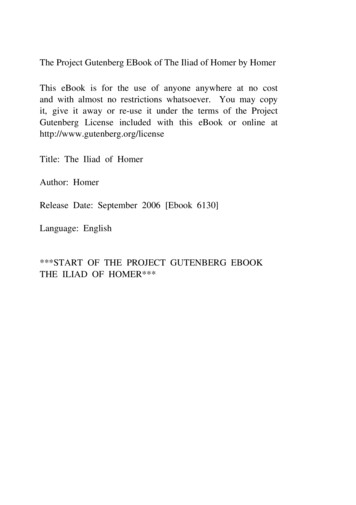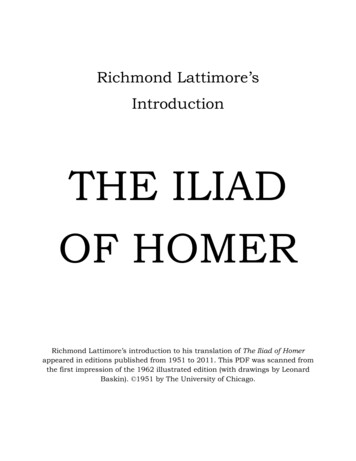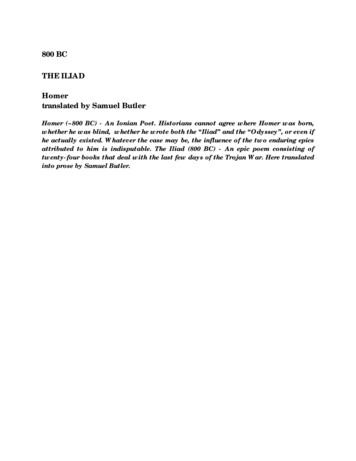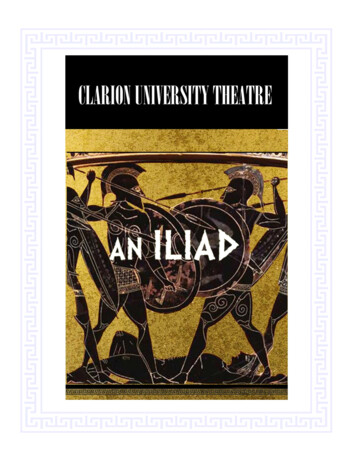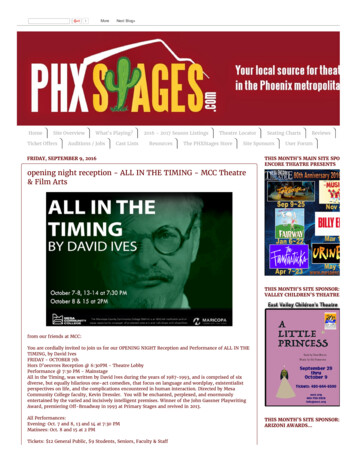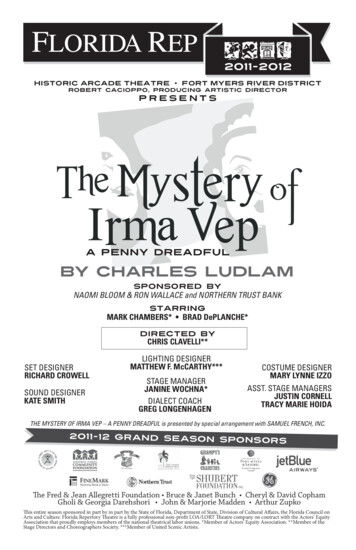
Transcription
AN ILIADAdapted from HomerBy Lisa Peterson and Denis O’HareTranslation by Robert FaglesDirected by Charles NewellNovember 13 – December 8, 2013 at Court Theatre-STUDY GUIDE-1
ABOUT THE PLAYCharactersThe Poet: Storyteller, narrator, Homeric voiceStoryAn Iliad is a one-actor adaptation of Homer’s The Iliad created by Lisa Peterson and DenisO’Hare and originated at the Seattle Repertory Theatre.The Iliad (sometimes referred to as the “Song of Ilion” or “Song of Ilium”) is an epic poemtraditionally attributed to Homer. Set during the Trojan War, a ten-year siege of the cityof Troy (Ilium) by a coalition of Greek states, it tells of the battles and events that tookplace during the weeks of a disagreement between the Greek King Agamemnon and thewarrior Achilles.Although the story covers only a few weeks in the final year of the war, The Iliadmentions or alludes to many Greek legends about the siege: earlier events, such as thegathering of warriors for the siege; the cause of the war; and future events, such asAchilles's looming death and the sack of Troy. In total, the poem tells a more or lesscomplete tale of the Trojan War.Along with The Odyssey, also attributed to Homer, The Iliad is among the oldest works ofWestern literature, and its written version is usually dated to around the eighth centuryBC. The Iliad contains over 15,000 lines and is written in Homeric Greek, a literaryamalgam of Ionic Greek with other dialects.Though it tells the story of The Iliad, An Iliad is not an exact adaptation of Homer’s text.Instead, it is a version of the story told by a modern narrator who is just as familiar withcurrent events as his ancient story, and often tries to help us understand the Trojan Warby putting it into a present-day context.2
Major Characters in The IliadGods and GoddessesZeus – King of the Greek gods and husband of Hera. He alternates between supporting the Greeks and the Trojans.Hera – Goddess of women and fertility, wife (and sister) of Zeus. Hera is often jealous and vengeful of Zeus’s lovers. She hates the Trojans.Athena – Greek virgin goddess of the discipline and art of war, wisdom, and truth; patron goddess of Athens and supporter of the Greeks. She is thought tobe the daughter of only Zeus, and to have sprung from his head full-grown and in full armor.Aphrodite – Greek goddess of love, beauty, and sexuality. She is also the unhappy and unfaithful wife of Hephaestus. She supports the Trojans.Apollo – God of the sun, medicine, archery, and the arts. Apollo is the son of Zeus and Leto, and has a twin sister, Artemis. He supports the Trojans.Ares – Ruthless god of war/slaughter, courage, masculinity, and brother of Athena. Loves war itself and supports the Trojans.Hephaestus – God of smiths and metal working; husband of unfaithful Aphrodite. Son of Zeus and Hera. He was raised by Thetis (mother of Achilles), and hecrafts Achilles’ brilliant armor. He supports the Greeks.Hermes – Described as a guide and giant-killer, son of Zeus. He is Zeus’ messenger–swift, shrewd, and cunning.Poseidon – God of the sea and younger brother of Zeus. Though he primarily interferes on the side of the Greeks, he backs down at Zeus’ behest.Thetis – A sea goddess and the mother of Achilles. Zeus fell in love with her but could not marry her due to a prophesy.Greeks (Achaeans)LeadershipAgamemnon – King of Mycenae, husband of Clytemnestra, brother to Menelaus, supreme commander of all Achaea’s armies. The conflict of The Iliad beginswhen he angers Achilles by taking Briseis, Achilles’ lover.Helen – The daughter of Zeus and the wife of Menelaus. The Trojan War begins when Paris abducts her from Sparta.Menelaus – King of Mycenian Sparta, husband of Helen (stolen by Paris of Troy). Brother of Agamemnon.WarriorsAchilles – Son of Peleus and Thetis, commander of the Myrmidons, Achaean allies. He is the champion of the Greeks, but his rage is the source of much of theconflict in The Iliad.Briseis – Captive and lover of Achilles. She is taken by Agamemnon, causing Achilles to fly into a rage.Diomedes – King of Argos. One of the strongest fighters for Achaea.Great Ajax – Commander of the contingent from Salamis. A champion for the Achaean army second only to Achilles.Odysseus – King of Ithaca and protagonist of Homer’s epic poem The Odyssey. Odysseus is known for his cunning; the Trojan Horse is his idea.Patroclus – Achilles’s best friend; borrows Achilles’s armor to fight in the war. His death inspires Achilles to return to battle.Other CharactersPeleus – Father of Achilles. His first marriage is to Antigone.Menoetius – Father of Patroclus.Atreus – Father of Menelaus and Agamemnon.Nestor – A former Argonaut. He is old at the time of the Trojan War, in which his sons fight. He offers counsel to Agamemnon and Achilles, and leads troops,but does not fight himself. He is the oldest of all the chieftains.3
Trojans (Dardans)Priam and his FamilyPriam – King of Troy, father of Hector and Paris. He goes to Achilles himself to request the body of Hector.Hecuba – Priam’s wife and Hector’s mother.Hector – Priam’s oldest son, Paris’s brother and Troy’s supreme commander. He kills Patroclus which spurs Achilles to return to war.Paris – Son of Priam and younger brother of Hector; a coward. He kidnaps Helen and begins the Trojan War.Andromache – Hector’s wife. She asks him not to return to war on his brief visit home.Astyanax – Hector’s baby son, eventually killed at the hands of the Greeks.Cassandra – Daughter of Priam and prophetess.Other CharactersAeneus – Son of Anchises and Aphrodite; favorite of Apollo.Anchises – Aphrodite’s mortal lover with whom she fathered Aeneus.How the Trojan War BeganLegend has it that at the wedding of Peleus and Thetis (Achilles’ parents), Eris, atroublemaking god who was not invited, threw an apple into the party for “the mostbeautiful woman” there. The goddesses Hera, Athena, and Aphrodite all claimed it. Thewomen asked Zeus to decide which of them was the most beautiful, but wantingnothing to do with the decision, Zeus passed the task along to Paris. All the goddessesoffered Paris gifts if he chose them, but he selected Aphrodite who promised him thelove of the most beautiful woman in the world, Helen. Unfortunately, Helen wasalready married to the Greek king Menelaus, and when Paris stole Helen from herhusband, Menelaus and his brother Agamemnon joined forces to declare war on Troy.The arrival of the Greek army at Troy marked the beginning of a ten-year siege thatfinally ended in the sacking and burning of Troy.The Procession of the Trojan Horse into Troy,Giovanni Tiepolo, 17604
Map of Homeric Greece5
HomerHomer is the author of The Iliad and The Odyssey and is revered as the greatest ancient Greek poet. His work has had an enormous influence onthe evolution of literature. When he lived is controversial: Herodotus (an ancient Greek historian who lived in the 5th century BCE) estimatesthat Homer lived 400 years before his own time, which would place Homer at around 850 BCE. Other ancient sources claim that he lived muchnearer to the supposed time of the Trojan War, in the early 12 th century BCE.For modern scholars, “the date of Homer” refers not to an individual, but to the period when his epics were created. The consensus is that TheIliad and The Odyssey date from around the 8th century BCE (The Iliad being composed before The Odyssey, perhaps by some decades), althoughsome scholars argue that the Homeric poems developed gradually over a long period of time. The debate over who Homer the individual was,known as the “Homeric question,” is fueled by the fact that we have no reliable biographical information handed down from classical antiquity.Homer’s poems are generally seen as the culmination of many generations of oral story-telling, in a tradition with a well-developed formulaicsystem of poetic composition. Some scholars, such as Martin West, claim that "Homer" is "not the name of a historical poet, but a fictitious orconstructed name."“The Homeric Question”By Evan Garrett, Court Theatre Dramaturgy InternThe formative influence played by the Homeric epics in shaping Greek culture was widely recognized,and Homer was described as the teacher of Greece. Homer's works, which are about fifty percentspeeches, provided models in persuasive speaking and writing that were emulated throughout theancient and medieval Greek worlds. Fragments of Homer account for about half of all ancient Greekpapyrus discoveries.Homer is undoubtedly the most well-known author from Ancient Greece. At the same time, he alsoremains one of the most mysterious authors of current scholasticism. Partly, this is due to the substantialdistance between our modern times and when he wrote. This distance has created a question ofauthorship notoriously known as “the Homeric question.” We do not know who, truthfully, wrote TheIliad and The Odyssey: it may have been a group of poets, a poor and blind nomad, a woman, anaristocrat, anyone—we simply do not have the information to make a solid claim. However, we can makehypotheses, use our imagination, and perform some impressive detective work to make a best guess—that is to say, to do what classical historians do. If (and what a big “if” that is!) Homer were to exist as asingle person, we would be able to use historical records, archaeology, and geographical evidence tomake educated claims of what type of person he would be.Bust of Homer dating to the HellenisticPeriod, on display at the British Museum6
Currently, it is thought that Homer must have composed his famous poems sometime in the 8th Century. The epic style of the poems hints thatthey would have needed to be composed sometime after 750 B.C.E. when Pan-Hellenic festivals celebrating poetry became popular. If this werethe case, Homer would have been traveling through the larger Greece , delivering his poems to adoring and upper-class fans. While this is ourbest guess based on archeology, one cannot ignore the fact that ancient authors dated Homer much earlier than this relatively late date.Herodotus claimed that Homer lived 400 years before he did—dating Homer to around 850 B.C.E. Other ancient authors claimed that Homermust have existed even closer to the Trojan War, sometime around 1200 B.C.E. Thus, it appears that there is a 500-year span of when Homermay have lived, with a larger likelihood on the later dates.The next unsolved mystery is determining where Homer would have lived. Much of the geology and flora described in The Iliad would make itseem that Homer had intimate knowledge of Ionia (roughly modern day Turkey). This would seem to place him somewhere where Ancient Troywould have been. However, Homer also illustrates a great deal of knowledge of island geography in his Odyssey, which would support the factthat he spent much time on various Greek isles. Many of the cities existing in Attica (the area around Athens) and even Laconia (Greece’sSouthern Peninsula) made claims that Homer rested in their town while composing his epic, which provides evidence (albeit weak) that Homermay have actually been a wandering poet traveling throughout Greece. These records are probably false, however—created by towns wantingto attract tourism and fame. Who wouldn’t want to spend a night in the same town as history’s greatest poet? Despite nomadic legends, it isimportant to note that Homer’s dialect was Ancient Ionic Greek, making the case, once again, for his more eastern roots.Why does there exist this idea of Homer as a “blind poet”? Most likely, it derives from his name “Ὅμηρος,” which in Ancient Greek roughlytranslates to “follower.” In the Eastern dialect of Greek, however, this word takes on the second and literal meaning, “blind.” Additionally, muchhas been written about the blind poet, Demodocus— appearing in Book 8 of The Odyssey—who recounts the story of the Trojan War to adisguised Odysseus. This has been described as a self-referential moment in the story where Homer powerfully illustrates the power andimportance of epic poetry as a tool for recording history and catharsis.This theory is acceptable, but must be taken with a grain of salt: not all great authors intentionally write themselves into their story. In general,modern scholars have no reason to think Homer was blind, especially since his poems include such strikingly visual descriptions. If anything,Homer’s “blindness” is another fiction we recount in order to maintain a mystery around the masterworks he created. While these are some ofthe knowns and unknowns of this ancient author, one is forced to acknowledge a very simple fact: our information of the ancient world isincomplete.Indeed, it is very likely that Homer is a fictive personage created by stringing together dozens of ancient poets’ renditions of war stories. We areso distanced from Homer’s time that we will probably never know for sure whether he actually existed. However, one may look at the evidencewe have so far and make the case that his poetry does seem to come from a common experience, from a common culture, and from a commonstyle. It is for this reason one should have no qualms stating that Homer, either the person or the idea, remains to be one of the most masterfulauthors standing the tests of time.7
A History of StorytellingAt the turn of the 20th century, a group of French children discovered drawings of extinctanimals in caves in the Pyrenées Mountains. The 35,000-year-old paintings on the walls of theLascaux Caves are the earliest recorded evidence of storytelling.Since this discovery, archaeologists have found dozens of other examples of primitivestorytelling. These caves (and others from the same period) represent not only the earliestrecorded storytelling art, but also the first instance of visual art of any sort, precursors tomodern cartoons, slide shows, and photo albums. While today’s technology may be modern,our storytelling methods have their roots in ancient traditions.To primitive humans, storytelling was magic. There was little separation between imaginedand actual events; in this stage of cultural development, humans believed that it should bepossible to describe an event in great detail in order to make it happen in the future.In ancient times, different stories – or different ways of telling the same stories – helped toshape and distinguish cultures. In fact, many believe that culture is rooted in storytelling;while our stories may be similar, the way in which we tell them is distinct and unique to ourparticular background. With storytelling came cultural and societal bonding. Many moderndisciplines, including psychology, religion, and science, have their roots in the oral tradition.Paintings discovered in the Lascaux Caves, a cavecomplex in southwestern France, on September 12,1940. Described as the “prehistoric Sistine Chapel.”Early CivilizationCivilization arose many thousands of years after storytelling, with the development ofagriculture and a more sedentary lifestyle. Humans began to settle in various regions in orderto farm; subsequently, farms grew into hamlets, hamlets to villages, and at last the first citieswere born. With the rise of cities also came local priests, who can be described as the firstprofessional storytellers.The first short stories were written down over 4,000 years ago in Egypt (Gilgamesh is thought to be the first written epic). A similar pattern canbe seen in China and India, with ancient stories written down long after they were apparently first composed. There are many common themesthat span different civilizations, such as catastrophic floods, creation myths, and fables explaining how things came to be. According toresearchers like Joseph Campbell, this is partly evidence of common experiences and partly evidence that stories had spread widely long beforethey were written down.8
Not only had the most ancient of stories and story forms been developed by the time they were written down, but genres had differentiated,though some were specific to their own cultures. Epic tales like Gilgamesh and some of the stories of the gods were sung or spoken to a rhythmby professional storytellers similar to bards. The more formal tales of the gods were told at religious ceremonies through hymns and lectures.The Dark AgesThe Dark Ages – a period in European history between the 5th and 15th centuries CE, following the collapse of the Roman Empire – were a timeof “intellectual darkness” in Europe, though not in rest of the world. The Middle East, for instance, was experiencing a brilliant renaissance, andChina and India were experiencing stable, growing cultures punctuated by periods of war with the Mongols and the same plagues thatdevastated Europe. Storytelling matured and changed during this time period, shaping cultures while also being shaped by them.Drawing on ancient Greek traditions of live theater, mystery plays were invented by the Catholic Church. These were a dramatic method fortelling the morality stories the Church wanted to spread. Since commoners generally could not read or understand the Latin in which serviceswere conducted, mystery plays allowed ordinary people to hear the stories of the Bible. By allowing and even encouraging mystery plays (whichtraveled from town to town), the Church ensured that the same story was told in the same way through the Catholic world.While illiteracy was common in Europe, it was quickly becoming uncommon in the Near East. Oral storytelling still had its place, even thoughIslamic teachings frowned upon it. The teachers and leaders of Islam encouraged all Islamic converts to learn to read, at least in order to readthe Quran. This, like mystery plays in the West, encouraged a homogeneousness of culture that bound together most of the Muslim people.The New WorldIn the Americas, stories were recorded in stone and on perishable materials such as hides and paper. Unfortunately, the Jesuits, who came toAmerica determined to convert the natives to Christianity, burned all of these perishable documents and broke the stones left by early CentralAmericans. As a result, much of the culture of the Aztecs, Mayans, and related cultures was lost. However, because of pictograms, we do havean idea of what some of the lost stories were. Quetzalcoatl, for example, was a Jesus-like figure to the Aztecs; he created man, according tolegend, by descending to the underworld and gathering the bones of the ancient dead and anointing them with his blood.Modern DayToday, most of the industrialized world is populated by literary cultures. Stories are recounted in books, in movies, and online. One of the mainvenues of storytellers today is the stand-up comic stage. Though not all comics are storytellers, enough are to keep the comedic story traditionalive. And this is especially true for storytellers in the American South, where storytelling traditions are kept alive in more isolated communitiesthroughout the Appalachians and rural communities. You can also find storytellers at a variety of cultural events.In much of the less-developed world, it is still possible to find local storytellers who sometimes travel to tell their tales. Stories today are told fora variety of reasons, including to provide entertainment, to engender pride in one’s personal and familial history, and to educate newgenerations about important cultural traditions.9
A Story for the Ages: An Iliad director Lisa Peterson shares why now is the best time to revisit the Trojan WarOriginally Published in Seattle Repertory Theatre MagazineIn books, on film, and now on the stage, the story of the Trojan War has been experiencing a renaissance in recent years. But what is it about a war thatoccurred thousands of years ago that remains so resonant today? An Iliad director Lisa Peterson supposes that there’s never really a wrong time to take anew look at the world’s oldest war story. “Somewhere in the world, people are always at war,” says Peterson.However, some times are more right than others to revisit the infamous conflict—particularly as it’s told through Homer’s classic tale, The Iliad. “Thisparticular moment, I think, is unique,” Peterson says. “The Iliad begins nine years into a war that may have lost its underlying meaning.” It’s a situation thatmirrors what many see in the current American military engagements in Iraq and Afghanistan.In the midst of the second Iraq war, Peterson found her own interest in dramatic responses to war sparked anew. As she was researching the topic anddiscussing it with colleagues, a friend made the argument that The Iliad was not a poem but a dramatic work. “It was a remnant of the oral tradition, it was anout-loud story; it was never intended to be something that you just read on paper. And I was really interested in that,” says Peterson. “I had studied The Iliadin college, but I had never thought of it as a play, and I don’t think most people do.”Peterson was also intrigued by the opportunity to put a unique theatrical spin on a literary classic. After taking a long hiatus from helming the adaptationsthat marked her early career as a director, she was eager to return to adapting work, though not in a traditional manner. “I wanted to work on something asan adapter, and I was really interested in working directly with an actor instead of with a writer,” Peterson says. “I was interested in the idea of Homer as atraveling storyteller, as opposed to someone who sits and writes, and so it made more sense to go to an actor friend.”Peterson began collaborating on the work with friend and performer Denis O’Hare, initiating a multi-year process. Last spring, An Iliad premiered at SeattleRep. While their original idea was an improvisational piece that would change slightly with every performance, “It did end up getting written down andcodified and now it is a script, but we are still trying to capture that sensation that he’s making it up on the spot,” Peterson says. “We’re trying to create thekind of feeling that might have been in the room thousands of years ago when Homer was telling the story.”Instilling that sense of awe at the spoken word in a modern audience is no small order. Peterson and O’Hare’s adaptation emphasizes the wide-rangingappeal of the tale and of storytelling, making An Iliad a bridge of sorts between the ancient and the modern. “We are imagining that our poet has beenaround for millennia. He was there during the war, and he is doomed to walk the earth and tell his story. And over the years, he has adapted, always, to bewherever he happens to be.”As the development process on An Iliad moves ahead, the original continues to surprise Peterson. “Almost every day I find something that I feel like I’venever read,” Peterson says. But not every surprise can be brought to the stage. In crafting a 90-minute one-person show from an epic poem, choosing whataspects of the story to explore can be difficult. Ultimately, An Iliad focuses on exploring the source material’s meditations on the nature of war. “We dug untilwe found the core of the story,” Peterson says, “and for us that core is the conflict between two great warriors, Hector and Achilles.”10
The One-Person ShowLisa Peterson and Denis O’Hare’s adaptation of The Iliad is a one-person show, a term thatoriginated primarily in reference to comedians who stood on stage alone and entertainedaudiences for an extended period of time. While a one-person show may be the musings ofa comedian on a theme, the form also includes "solo performances," which are dramaticworks performed by one person, though not necessarily by someone with a background incomedy. In the preface to Extreme Exposure: An Anthology of Solo Performance Texts fromthe Twentieth Century, editor Jo Bonney explains that "at the most basic level, despite theirlimitless backgrounds and performance styles, all solo performers are storytellers." Thisassumption is based on her assertion that a number of solo shows have a storyline or a plot.Bonney also suggests that a distinctive trait of solo performance is the lack of a “fourthwall” separating the performer from the audience. She states that a "solo show expects anddemands the active involvement of the people in the audience." While this is often thecase, as in the shows of performers coming directly from the stand-up comedy tradition, itis not a requirement.As one-person shows began in the comedy realm, prominent solo performers includecomedians Lily Tomlin, Andy Kaufman, Eric Bogosian, Whoopi Goldberg, John Leguizamo,and Lenny Bruce. Several performers have presented solo shows in tribute to famouspersonalities, including Julie Harris in The Belle of Amherst (a biography of EmilyDickenson); Tovah Feldshuh as Golda Meir in Golda's Balcony; and Ed Metzger as ErnestHemingway in Hemingway, On The Edge.One-person shows (such as An Iliad) may be personal, autobiographical creations like theintensely confessional but comedic work of Spaulding Gray or the semi-autobiographical ABronx Tale by Chaz Palminteri. Other types of one-person shows may center on a certaintheme, such as pop culture in Pat Hazel's The Wonderbread Years; the history of the NewYork City transit system in Mike Daisey's Invincible Summer; or rebelling against ‘thesystem’ in Patrick Combs' Man 1, Bank 0. Sometimes, however, solo shows are simplytraditional plays written by playwrights for a cast of one, such as I Am My Own Wife byDoug Wright.Other art forms also find representation in the solo performance genre; poetry pervadesthe work of Dael Orlandersmith, sleight-of-hand mastery informs Ricky Jay's self-titled RickyJay and His 52 Assistants, and magical and psychic performance skills are part of NeilTobin's Supernatural Chicago.The “Fourth Wall”In theatre, the “fourth wall” refers to the imaginary wall atthe front of the stage in a proscenium theatre throughwhich the audience sees into the world of the play. Theterm also applies to the boundary between any fictionalsetting and its audience. When this boundary is "broken"(for example, by an actor speaking to the audience directly),it is called "breaking the fourth wall."The term was made famous in the nineteenth century withthe advent of theatrical realism. The critic Vincent Canbydescribed it in 1987 as "that invisible screen that foreverseparates the audience from the stage."The term "fourth wall" stems from the absence of a fourthwall on a three-walled set where the audience is viewing theproduction. The audience is supposed to assume there is a"fourth wall" present, even though it does not physicallyexist.The term "fourth wall" has also been adapted to refer to theboundary between the fiction and the audience. "Fourthwall" is part of the suspension of disbelief between afictional work and an audience. The audience accepts thepresence of the fourth wall without giving it any directthought, allowing them to enjoy the fiction as if they wereobserving real events, but without interaction with oracknowledgment from any of the characters on stage.The presence of a fourth wall is an established conventionof fiction and drama; this has led some artists to draw directattention to it for dramatic or comedic effect, thus"breaking the fourth wall" and addressing the audiencedirectly.11
About the ArtistsLisa Peterson (Playwright/Director)Recent credits: An Iliad (Seattle Rep), Surf Report (La Jolla Playhouse) and Romance (Bay Street). NY credits:The Poor Itch, Tongue of a Bird and The Square (Public Theater); Shipwrecked and Model Apartment(Primary Stages); Tight Embrace (INTAR); Birdy and Chemistry of Change (WPP); The Fourth Sister and TheBatting Cage (Vineyard); Collected Stories (MTC); Sueno (MCC); Bexley, OH, Slavs!, Traps, The Trestle at PopeLick Creek, Light Shining in Buckinghamshire (OBIE award) and The Waves, which Lisa adapted from thenovel with David Bucknam (all at NYTW). Regional work: Mark Taper Forum, La Jolla Playhouse, Guthrie,Hartford Stage, OSF, Berkeley Rep, Cal Shakes, Yale Rep, Arena Stage, Huntington, Actors Theater ofLouisville. Yale College graduate, SDC executive board member.Denis O’Hare (Playwright)Denis O’Hare is an actor and writer who lives in Fort Greene, Brooklyn. This is his first collaboration and hisdebut as a writer for the theater. He has written two screenplays as well as short stories and poetry. While atNorthwestern pursuing an acting degree, Denis followed the poetry writing program for two years and studiedpoetry under Alan Shapiro, Mary Kinzie and Reginald Gibbons. He has appeared on Broadway and OffBroadway numerous times as well as in many regional theaters, including McCarter, where he was seen inBrian Friel’s Wonderful Tennessee, directed by Doug Hughes. He has appeared in many films including Milk,Michael Clayton, Charlie Wilson’s War, A Mighty Heart, Duplicity, An Englishman in New York, 21 Grams,Garden State, and the upcoming Eagle. His TV work includes roles on Brothers and Sisters, CSI Miami, and all ofthe Law and Order franchises. Recently, he completed Season 3 of True Blood as the Vampire King RussellEdgington.12
Discussion & Follow-up Questions1. Co-authors Lisa Peterson and Denis O’Hare chose to title their play An Iliad to show that this is not THE Iliad, but rather one possible retelling of it. Consider Peterson and O’Hare’s intentions when you see the play; what aspects of the production (including staging, storystructure, dialogue and exposition, etc) support this intention? Why?2. Does An Iliad condemn warfare? Why or why not?3. What similarities, if any, do you see between the Trojan War as described in An Iliad and the modern wars in Iraq and Afghanistan?4. The character of the Poet, played by Timothy Edward Kane, seems to exist outside of a specific time in history. Based on your experienceof the play, in your opinion, where did he come from? Why is he telling this story to the audience at this specific moment in time?5. Director Lisa Peterson has been quoted as saying that An Iliad is m
6 Homer Homer is the author of The Iliad and The Odyssey and is revered as the greatest ancient Greek poet. His work has had an enormous influence on the evolution of literature. When he lived is controversial: Herodotus (an ancient Greek historian who lived in the 5th century BCE) estimates that Homer lived 400 years
